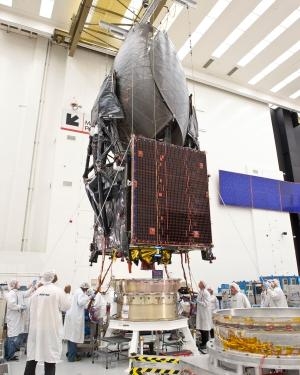Tue, Dec 25, 2012
Tracking And Data Relay Spacecraft Scheduled For Jan. 29 Launch
NASA's newest Tracking and Data Relay Satellite, known as TDRS-K, has arrived at the agency's Kennedy Space Center in Florida in preparation for launch January 29. TDRS-K arrived aboard a U.S. Air Force C-17 from the Boeing Space and Intelligence Systems assembly facility in El Segundo, CA.

For almost 30 years, the TDRS spacecraft have provided a reliable communications network for NASA, serving numerous national and international space missions. The TDRS fleet is a space-based communication system used to provide tracking, telemetry, command, and high bandwidth data return services. The satellites provide in-flight communications with spacecraft operating in low-Earth orbit. It has been 10 years since NASA's last TDRS launch. "This launch will provide even greater capabilities to a network that has become key to enabling many of NASA's scientific discoveries," says Jeffrey Gramling, project manager for TDRS at NASA's Goddard Space Flight Center in Greenbelt, MD.
TDRS-K will launch to geostationary orbit aboard an Atlas V rocket. The spacecraft is the first of three next-generation satellites designed to ensure vital operational continuity for NASA by expanding the lifespan of the fleet. The launch of TDRS-L is scheduled for 2014 and TDRS-M in 2015. Each of the new satellites has a higher performance solar panel design to provide more spacecraft power. This upgrade will return signal processing for the S-Band multiple access service to the ground -- the same as the first-generation TDRS spacecraft. Ground-based processing allows TDRS to service more customers with different and evolving communication requirements.

The TDRS fleet began operating during the space shuttle era and provides critical communication support from several locations in geostationary orbit to NASA's human spaceflight endeavors, including the International Space Station. The fleet also provides communications support to an array of science missions, as well as various types of launch vehicles. Of the nine TDRS satellites launched, seven are still operational, although four are already beyond their design life. Two have been retired. The second TDRS was lost in 1986 during the space shuttle Challenger accident.
NASA's Space Communications and Navigation Program, part of the Human Exploration and Operations Mission Directorate at the agency's Headquarters in Washington, is responsible for the TDRS network. NASA's Launch Services Program at Kennedy is responsible for launch management. United Launch Alliance provides the Atlas V rocket launch service.
(TDRS-K satellite image provided by NASA)
More News
Secondary Radar/Radar Beacon (ATCRBS) A radar system in which the object to be detected is fitted with cooperative equipment in the form of a radio receiver/transmitter (transponde>[...]
Aero Linx: Royal Aeronautical Society (RAeS) As the only professional body dedicated to aerospace, aviation and space communities, we exist to further the advancement of aeronautic>[...]
While Conducting A Wheel Landing The Tailwheel Equipped Airplane, It Bounced Twice... Analysis: The pilot reported that while conducting a wheel landing the tailwheel equipped airp>[...]
Also: Bristell Receives Part 23, Sonex Highwing Webinar, AV-30-C Update, MOSAIC Consultancy The GA community is eagerly anticipating the date that marks the beginning of a new era >[...]
Radar Contact Lost Used by ATC to inform a pilot that the surveillance data used to determine the aircraft's position is no longer being received, or is no longer reliable and rada>[...]
 ANN's Daily Aero-Term (10.01.25): Secondary Radar/Radar Beacon (ATCRBS)
ANN's Daily Aero-Term (10.01.25): Secondary Radar/Radar Beacon (ATCRBS) ANN's Daily Aero-Linx (10.01.25)
ANN's Daily Aero-Linx (10.01.25) NTSB Final Report: Cessna 190
NTSB Final Report: Cessna 190 Airborne Affordable Flyers 10.02.25: MOSAIC Start Date, AFE25 Tickets, ePulitzer
Airborne Affordable Flyers 10.02.25: MOSAIC Start Date, AFE25 Tickets, ePulitzer ANN's Daily Aero-Term (10.02.25): Radar Contact Lost
ANN's Daily Aero-Term (10.02.25): Radar Contact Lost




